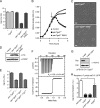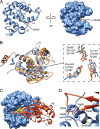Identification, structure, and function of a novel type VI secretion peptidoglycan glycoside hydrolase effector-immunity pair
- PMID: 23878199
- PMCID: PMC3772208
- DOI: 10.1074/jbc.M113.488320
Identification, structure, and function of a novel type VI secretion peptidoglycan glycoside hydrolase effector-immunity pair
Abstract
Bacteria employ type VI secretion systems (T6SSs) to facilitate interactions with prokaryotic and eukaryotic cells. Despite the widespread identification of T6SSs among Gram-negative bacteria, the number of experimentally validated substrate effector proteins mediating these interactions remains small. Here, employing an informatics approach, we define novel families of T6S peptidoglycan glycoside hydrolase effectors. Consistent with the known intercellular self-intoxication exhibited by the T6S pathway, we observe that each effector gene is located adjacent to a hypothetical open reading frame encoding a putative periplasmically localized immunity determinant. To validate our sequence-based approach, we functionally investigate a representative family member from the soil-dwelling bacterium Pseudomonas protegens. We demonstrate that this protein is secreted in a T6SS-dependent manner and that it confers a fitness advantage in growth competition assays with Pseudomonas putida. In addition, we determined the 1.4 Å x-ray crystal structure of this effector in complex with its cognate immunity protein. The structure reveals the effector shares highest overall structural similarity to a glycoside hydrolase family associated with peptidoglycan N-acetylglucosaminidase activity, suggesting that T6S peptidoglycan glycoside hydrolase effector families may comprise significant enzymatic diversity. Our structural analyses also demonstrate that self-intoxication is prevented by the immunity protein through direct occlusion of the effector active site. This work significantly expands our current understanding of T6S effector diversity.
Keywords: Effector-Immunity Pair; Glycoside Hydrolases; Interbacterial Interactions; Microbiology; Peptidoglycan; Protein Crystallization; Protein Secretion; Type VI Secretion.
Figures




Similar articles
-
Structure of a peptidoglycan amidase effector targeted to Gram-negative bacteria by the type VI secretion system.Cell Rep. 2012 Jun 28;1(6):656-64. doi: 10.1016/j.celrep.2012.05.016. Epub 2012 May 31. Cell Rep. 2012. PMID: 22813741 Free PMC article.
-
Complex structure of type VI peptidoglycan muramidase effector and a cognate immunity protein.Acta Crystallogr D Biol Crystallogr. 2013 Oct;69(Pt 10):1889-900. doi: 10.1107/S090744491301576X. Epub 2013 Sep 20. Acta Crystallogr D Biol Crystallogr. 2013. PMID: 24100309 Free PMC article.
-
Diverse NADase effector families mediate interbacterial antagonism via the type VI secretion system.J Biol Chem. 2018 Feb 2;293(5):1504-1514. doi: 10.1074/jbc.RA117.000178. Epub 2017 Dec 13. J Biol Chem. 2018. PMID: 29237732 Free PMC article.
-
A holin/peptidoglycan hydrolase-dependent protein secretion system.Mol Microbiol. 2021 Mar;115(3):345-355. doi: 10.1111/mmi.14599. Epub 2020 Oct 12. Mol Microbiol. 2021. PMID: 32885520 Review.
-
VgrG, Tae, Tle, and beyond: the versatile arsenal of Type VI secretion effectors.Trends Microbiol. 2014 Sep;22(9):498-507. doi: 10.1016/j.tim.2014.06.004. Epub 2014 Jul 17. Trends Microbiol. 2014. PMID: 25042941 Review.
Cited by
-
Structure and Function of the T4 Spackle Protein Gp61.3.Viruses. 2020 Sep 24;12(10):1070. doi: 10.3390/v12101070. Viruses. 2020. PMID: 32987925 Free PMC article.
-
Coevolution of the ATPase ClpV, the sheath proteins TssB and TssC, and the accessory protein TagJ/HsiE1 distinguishes type VI secretion classes.J Biol Chem. 2014 Nov 21;289(47):33032-43. doi: 10.1074/jbc.M114.600510. Epub 2014 Oct 10. J Biol Chem. 2014. PMID: 25305017 Free PMC article.
-
Integrated transcriptomic and secretomic approaches reveal critical pathogenicity factors in Pseudofabraea citricarpa inciting citrus target spot.Microb Biotechnol. 2019 Nov;12(6):1260-1273. doi: 10.1111/1751-7915.13440. Epub 2019 Jun 4. Microb Biotechnol. 2019. PMID: 31162831 Free PMC article.
-
Molecular weaponry: diverse effectors delivered by the Type VI secretion system.Cell Microbiol. 2015 Dec;17(12):1742-51. doi: 10.1111/cmi.12532. Epub 2015 Nov 3. Cell Microbiol. 2015. PMID: 26432982 Free PMC article. Review.
-
Lipopolysaccharide transport regulates bacterial sensitivity to a cell wall-degrading intermicrobial toxin.PLoS Pathog. 2023 Jun 26;19(6):e1011454. doi: 10.1371/journal.ppat.1011454. eCollection 2023 Jun. PLoS Pathog. 2023. PMID: 37363922 Free PMC article.
References
-
- Hood R. D., Singh P., Hsu F., Güvener T., Carl M. A., Trinidad R. R., Silverman J. M., Ohlson B. B., Hicks K. G., Plemel R. L., Li M., Schwarz S., Wang W. Y., Merz A. J., Goodlett D. R., Mougous J. D. (2010) A type VI secretion system of Pseudomonas aeruginosa targets a toxin to bacteria. Cell Host Microbe 7, 25–37 - PMC - PubMed
-
- Leiman P. G., Basler M., Ramagopal U. A., Bonanno J. B., Sauder J. M., Pukatzki S., Burley S. K., Almo S. C., Mekalanos J. J. (2009) Type VI secretion apparatus and phage tail-associated protein complexes share a common evolutionary origin. Proc. Natl. Acad. Sci. U.S.A. 106, 4154–4159 - PMC - PubMed
Publication types
MeSH terms
Substances
Associated data
- Actions
Grants and funding
LinkOut - more resources
Full Text Sources
Other Literature Sources

